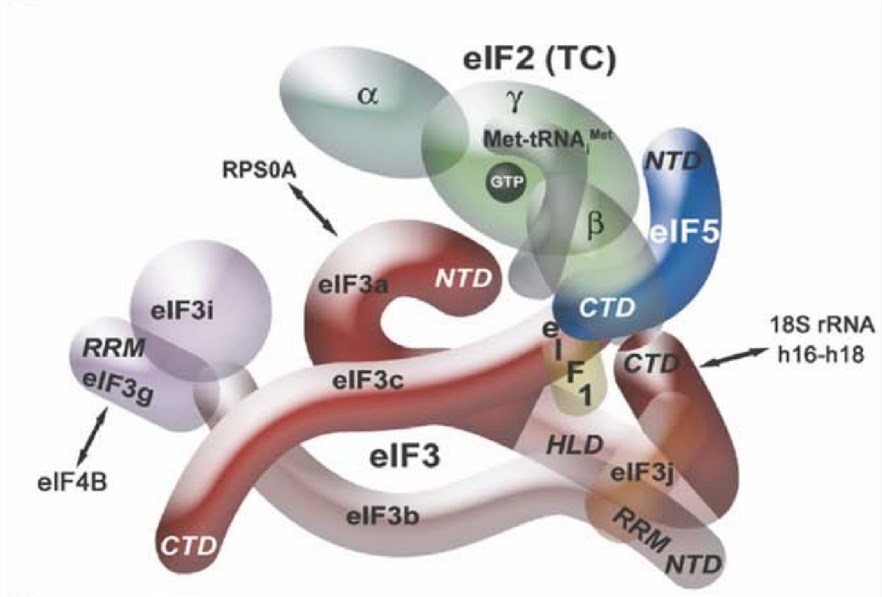What is EIF3I Protein
What is EIF3I Protein?
EIF3I, standing for Eukaryotic Translation Initiation Factor 3 Subunit I, commands attention as an indispensable component of the eukaryotic translation initiation factor 3 (eIF3) complex. This complex orchestrates the initiation of protein synthesis, a cardinal process for cellular function. EIF3I, a subunit of eIF3, is instrumental in coordinating the assembly of the translation initiation machinery, facilitating the accurate commencement of protein translation.

Figure 1. Interactions of eIF3 with other initiation factors and the 40S subunit. (Hinnebusch, A.G., et al. 2006)
The Function of EIF3I Protein
EIF3I's primary role unfolds in the initiation phase of protein synthesis. As a constituent of the eIF3 complex, EIF3I contributes to the stabilization of the complex, fostering its interaction with other initiation factors and mRNA. This orchestration ensures the precise assembly of the translation initiation machinery, regulating protein synthesis—a process indispensable for cell growth, proliferation, and maintenance.
EIF3I-Related Diseases
- Cancer
The involvement of EIF3I in cancer development and progression positions it as a potential biomarker and therapeutic target. Dysregulation of EIF3I expression may contribute to uncontrolled cell growth, making it a focal point in oncological research.
- Neurological Disorders
Emerging evidence suggests a connection between EIF3I and neurological disorders. Disruptions in protein synthesis, influenced by EIF3I dysfunction, could be implicated in neurodegenerative conditions, opening avenues for novel insights into diseases like Alzheimer's and Parkinson's.
EIF3I Related Signaling Pathways
- mTOR Pathway
EIF3I intersects with the mammalian target of rapamycin (mTOR) pathway, a central regulator of cell growth and protein synthesis. Dysregulation of this pathway, involving EIF3I, is observed in cancer and underscores its potential as a target for therapeutic interventions.
- MAPK/ERK Pathway
The mitogen-activated protein kinase/extracellular signal-regulated kinase (MAPK/ERK) pathway, crucial for cell proliferation and survival, is modulated by EIF3I. Disruptions in this crosstalk could contribute to pathological conditions, emphasizing the intricate connections between EIF3I and cellular signaling.
Applications of EIF3I in Biomedical Research
- Target for Drug Development
The pivotal role of EIF3I in diseases, particularly cancer, positions it as a compelling target for drug development. Inhibiting or modulating EIF3I activity may offer targeted approaches to cancer therapy by disrupting aberrant translation initiation in cancer cells.
- Biomarker for Disease Diagnosis
EIF3I's aberrant expression in various diseases, especially cancer, makes it a potential biomarker for diagnostic purposes. Detection of EIF3I levels in patient samples could facilitate early disease diagnosis and prognosis, enabling timely and targeted interventions.
- Understanding Neurological Disorders
Exploring the link between EIF3I and neurological disorders presents an opportunity for unraveling the molecular basis of conditions like Alzheimer's and Parkinson's. This understanding may pave the way for developing therapeutic strategies targeting EIF3I in the nervous system.
- Therapeutic Target in Viral Infections
Given its role in translation initiation, EIF3I emerges as a potential therapeutic target in viral infections. Disrupting EIF3I activity could impede viral protein synthesis, offering a promising avenue for antiviral drug development.
EIF3I protein emerges as a linchpin in cellular dynamics, influencing processes critical for cellular function. As we navigate the complexities of EIF3I, we uncover potential therapeutic avenues and gain deeper insights into fundamental cellular mechanisms, heralding a new era in precision medicine and targeted therapies.
Recommended Products for EIF3I Protein
| Cat.# | Species | Product name | Source (Host) | Tag |
|---|---|---|---|---|
| EIF3I-3187H | Human | Recombinant Human EIF3I Protein, GST-tagged | Wheat Germ | GST |
| EIF3I-1534H | Human | Recombinant Human EIF3I, T7-tagged | E.coli | T7 |
| EIF3I-310H | Human | Recombinant Human eukaryotic translation initiation factor 3, subunit I, His-tagged | E.coli | His |
| EIF3I-3218H | Human | Recombinant Human EIF3I Protein, Myc/DDK-tagged, C13 and N15-labeled | HEK293T | Myc/DDK |
| EIF3I-4275HF | Human | Recombinant Full Length Human EIF3I Protein, GST-tagged | In Vitro Cell Free System | GST |
| Eif3i-2781M | Mouse | Recombinant Mouse Eif3i Protein, Myc/DDK-tagged | HEK293T | Myc/DDK |
| EIF3I-2062R | Rat | Recombinant Rat EIF3I Protein | Mammalian Cell | His |
| EIF3I-1719R | Rat | Recombinant Rat EIF3I Protein, His (Fc)-Avi-tagged | HEK293 | His (Fc)-Avi |
| EIF3I-12234Z | Zebrafish | Recombinant Zebrafish EIF3I | Mammalian Cell | His |
| EIF3I-4000C | Chicken | Recombinant Chicken EIF3I | Mammalian Cell | His |
Reference
- Hinnebusch, A.G. eIF3: a versatile scaffold for translation initiation complexes. Trends Biochem Sci. 2006, 31(10): 553-62.

